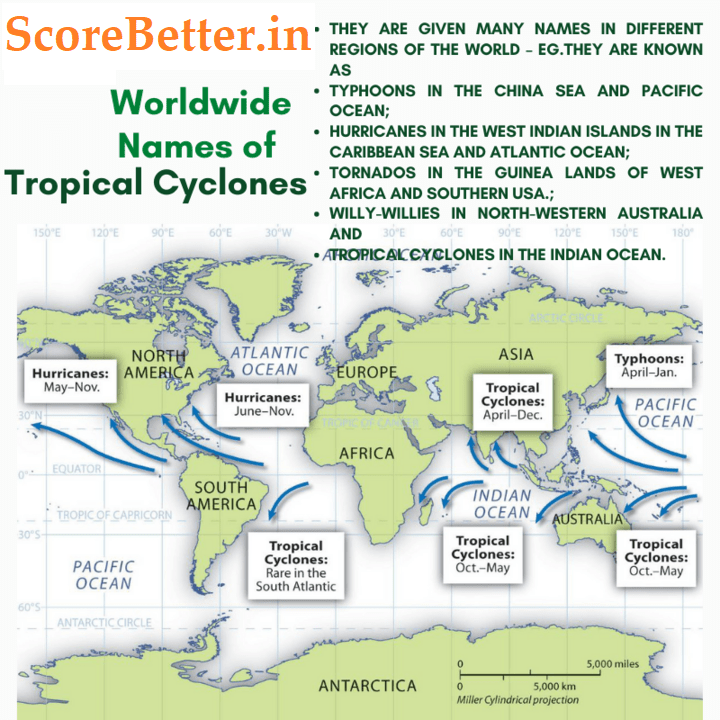The Tauktae Cyclone developed over the Arabian Sea on May 14, 2021, and got converted into a very severe cyclonic storm (VSCS) on May 16, 2021. It hit southern Gujarat on May 18, 2021. Strong cyclones have been developing on the Arabian Sea more frequently in recent times.

About Tropical Cyclones
- They are violent storms that form over oceans in tropical areas.
- They create a whirl in the atmosphere with very strong winds circulating around it. The direction is anticlockwise in the Northern Hemisphere and clockwise in the Southern Hemisphere.
- The winds try to converge towards the center from all directions.
- They develop in the North Indian Ocean region (Bay of Bengal and Arabian Sea) during the pre-monsoon and post-monsoon (October to December) periods.
- 76 per cent of India’s coastline is prone to cyclones.

Conditions for Formation of Tropical Cyclones
- A consistent source of heat
- Large sea surface with a temperature higher than 27° C.
- Presence of the Coriolis force. It deflects objects to the right in the Northern Hemisphere and to the left in the Southern Hemisphere.
- Small variations in the vertical wind speed.
- A pre-existing weak low-pressure area or low-level-cyclonic circulation;
- Upper divergence above the sea level system.
Past Trend of Cyclonic Activities
- During the period 1891-2000, nearly 300 tropical cyclones crossed the east coast, of which 103 were severe in intensity. Similarly, 48 cyclones crossed the west coast of which 24 were severe.
Trend of increasing cyclonic activities in the Arabian Sea
- Earlier, tropical cyclones in the Arabian Sea were restricted to Gujarat. Now even Kerala and Karnataka have also become more vulnerable to cyclones. A recent example is ‘Ockhi’.
- Tauktae is the fourth cyclone in consecutive years to have developed in the Arabian Sea. Cyclone Mekanu hit Oman in 2018, Cyclone Vāyu struck Gujarat in 2019 and Cyclone Nisarga hit Maharashtra in 2020.
- All these cyclones since 2018 have been categorised either ‘Severe Cyclone’ or above.
- Tauktae took only 2 days to become VSCS while Cyclone Mekanu and Cyclone Nisarga had developed slower, taking 4 and 5 days respectively.
Reasons behind changing trends
- Sea surface temperatures in the Arabian Sea have increased rapidly during the past century due to global warming. Temp. now is 1.2–1.4 °C higher than the temperature witnessed four decades ago. These warmer temperatures support active convection, heavy rainfall, and intense cyclones.
- Arabian Sea is also providing conducive wind shear for cyclones.
- Greater occurrence of El Niño Modoki. It is a climate phenomenon that creates conditions that are not conducive for cyclogenesis in the Bay of Bengal. However, this condition is conducive for the formation of cyclones in the Arabian Sea.
Concerns associated with changing trends
- There is a concern about the impact of the cyclonic storm on the battle against Covid-19.
- Delay in Monsoon: The cyclone Tauktae is expected to interfere with the normal progression of the Indian Monsoon by sucking all the moisture from the monsoon winds towards itself.
- Widespread extreme rainfall events that cause floods have also increased by threefold over India. Lo
- Best State-of-the-art cyclone models are unable to pick this rapid intensification because they do not incorporate the ocean dynamics accurately.
Initiatives launched by Government towards Cyclones
- National Cyclone Risk Mitigation Project (NCRMP) to upgrade cyclone forecasting, tracking, and warning systems in India
- Integrated Coastal Zone Management Project (ICZMP) to improve national capacity for the implementation of comprehensive coastal management in India.
.
You Can Follow on Youtube – Score Better
Read More Article of Current Affairs
.
